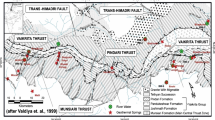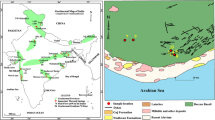Abstract
The energy demand is increasing exponentially on the global scale. To meet this demand, new alternative energy sources are explored, and geothermal energy makes one of the important renewable resources. Inherently, the north-eastern states of India have enormous geothermal potential; however, detailed studies evaluating their geothermal potential are quite limited. In view of this, the Garampani and Gelekipung thermal spring clusters of Karbi Anglong district, Assam (India), were evaluated for their geochemical characteristics and geothermal reservoir potential. Water samples from the thermal springs along with groundwater and river water from the surrounding areas were collected seasonally and investigated for various parameters. Thermal waters are NaCl type and show distinct physico-chemical characteristics, as compared to groundwater (Na-HCO3) and surface water (Ca-HCO3 type). The chemistry of thermal water indicates long-term water–rock interactions with the basement rock and does not show an appreciable seasonal variability. The influence of thermal water on groundwater chemistry has been observed during the pre-monsoon season. However, in the post-monsoon season, the delayed monsoonal freshwater influxes seem to diminish any such effect on the groundwater chemistry. The placement of thermal waters in the mature water field of the anion variation diagram confirms their suitability for chemical geothermometry. Silica and cation geothermometry indicates that the geothermal reservoir temperature ranges between 76.3 and 105.8 °C. Thus a low-enthalpy geothermal system exists in the Garampani and Gelekipung thermal spring areas. The radiogenic heat production of the granitic basement rock of the study area was found to range between 2.49 and 8.14 μW/m3.





Similar content being viewed by others
References
Abbady AGE, El-Arabi AM, Abbady A (2006) Heat production rate from radioactive elements in igneous and metamorphic rocks in Eastern Desert. Egypt Appl Radiation Isotopes 64:131–137
Alcicek H, Bulbul A, Alcicek MC (2016) Hydrogeochemistry of the thermal waters from the Yenice Geothermal Field (Denizli Basin, Southwestern Anatolia, Turkey). J Volcanol Geotherm Res 309:118–138
APHA (1998) Standard Methods for the examination of water and waste water American Public Health Association. 874pp.
Appelo CAJ, Postma D (2010) Geochemistry, groundwater and pollution, 2nd edn. CRC Pressb Balkema Publicattions, The Netherlands, p 635
Arnorsson S (1983) Chemical equilibria in icelandic geothermal systems-implications for chemical geothermometry Investigations. Geothermics 12:119–128
Arnorsson S, E Gunnlaugsson, and H Svavarsson (1983) The Chemistry of Geothermal Waters in Iceland. III. Chemical Geothermometry in Geothermal Investigations. Geochimica et Cosmochimica Acta 47(3): 567–77.
Baruah MP, Bezbaruah D, Goswami TK (2020) Active tectonics deduced from geomorphic indices and its implication on economic development of water resources in South-Eastern part of Mikir massif Assam, India. Geol Ecol Landsc. https://doi.org/10.1080/24749508.2020.1754705
Ben Brahim F, Makni J, Bouri S, Dhia HB (2014) Evaluation of temperature and mixing process of water in deep and shallow aquifers in the Southwestern Tunisia: Case of Djerid Region. Arab J Sci Eng 39:5677–5689. https://doi.org/10.1007/s13369-014-1138-z
Biswas S, Coutand I, Grujie D, Hager C, St¨ockli D and Grasemann B (2007) Exhumation and uplift of the Shillong plateau and its influence on the eastern Himalayas: New constraints from apatite and zircon (U-Th-Sm)/He and apatite fission track analyses; Tectonics, 26:TC6013, https://doi.org/10.1029/2007TC002125
Bulbul A (2015) Mixing of geothermal and non-geothermal fluids in shallow aquifers in the Germencik-Nazilli Area, Büyük Menderes Basin (SW Turkey). Geodin Acta 27(1):67–81. https://doi.org/10.1080/09853111.2014.979529
Buragohain AK, Ganguly D, Surender Nath M (1993) A report on quaternary geological and geomorphological mapping of brahmaputra valley in parts of Karbi Anglong, Golaghat and Jorhat Districts, Assam. Unpublished Progress Report, G.S.I
Chandramadhav (1990) Quaternary geology and geomorphology in parts of Kohima, Wokha, Mokokchung and Mon districts, Nagaland. Rec Gol Surv 123: 64–65
Chandrasekharam D (2000) Geothermal energy resources of india: country update. In: World Geothermal Congress, Kyushu-Tohoku, Japan
Chandrasekharam D, Antu MC (1995) Geochemistry of Tattapani thermal springs, Madhya Pradesh. India-Field Experimental Investigations Geothermics 24(4):553–559
Chandrasekharam D, Chandrasekhar V (2010) Geochemistry of Thermal Springs of Orissa. India GRC Trans 34:665–667
Chatterjee S, Sinha UK, Deodhar AS, Ansari MA, Singh N, Srivastava AK, Aggarwal RK, and Dash A (2017) Isotope–Geochemical Characterization and Geothermometrical Modeling of Uttarakhand Geothermal Field, India. Environ Earth Sci 76 (18). https://doi.org/10.1007/s12665-017-6973-2.
Das NK, Bhandari RK, Sen P, Sinha B (2005) The Helium Potential of India. Curr Sci 88(12):1883–1888
Farooq SH, Prusty P, Singh RK, Sen S, & Chandrasekharam D (2018) Fluoride contamination of groundwater and its seasonal variability in parts of Purulia district, West Bengal, India. Arab J Geosci 11(22). https://doi.org/10.1007/s12517-018-4062-9
Fawell J, Bailey K, Chilton J, Dahi E, Fewtrell L, Magara Y(2006) Fluoride in drinking water. World Health Organization. https://apps.who.int/iris/handle/10665/43514
Fourier RO (1977) Chemical geothermometers and mixing models for geothermal 131 systems. Geothermics 5(1–4):41–50. https://doi.org/10.1016/0375-6505(77)90007-4
Fournier RO (1979) Geochemical and hydrologic considerations and the use of enthalpy-chloride diagrams in the prediction of underground conditions in hot-spring systems. J Volcanol Geoth Res 5:1–16
Fournier RO (1983) A method of calculating quartz solubilities in aqueous sodium chloride solution. Geochim Cosmochim Acta 47:579–586
Fournier RO, Potter RW (1979) Magnesium correction to the Na–K–Ca chemical geothermometer. Geochim Cosmochim Acta 43(9):1543–1550. https://doi.org/10.1016/0016-7037(79)90147-9
Fournier RO, Truesdell AH (1973) An empirical Na–K–Ca geothermometer for natural waters. Geochim Cosmochim Acta 37:1255–1275
Geology and Mineral Resources of Assam (2009) Geological Survey of India. Miscellaneous Publication, no. 30, Part IV, vol 2(i). Assam, pp 1–51
Giggenbach WF (1988) Geothermal solute equilibria- derivation of Na–K–Mg–Ca geoindicators. Geochim Cosmochim Acta 52:2749–2765
Glassley WE (2015) Geothermal energy: renewable energy and the environment, 2nd edn. CRC press. Boca Raton, pp 423. https://doi.org/10.1201/b17521
Grasby SE, Betcher RN (2002) Regional hydrogeochemistry of the carbonate rock aquifer, southern Manitoba. Can J Earth Sci 39:1053–1063
Han DM, Liang X, Jin MG, Currell MJ, Song XF, Liu CM (2010) Evaluation of groundwater hydrochemical characteristics and mixing behavior in the daying and qicun geothermal systems, Xinzhou Basin. J Volcanol Geoth Res 189(1–2):92–104. https://doi.org/10.1016/j.jvolgeores.2009.10.011
Hem JD (1985) Study and interpretation of the chemical characteristics of natural water. US Geological Survey Water-Supply Paper 2254:1–263
Hudak PF, Sanmanee S (2003) Spatial patterns of nitrate, chloride, sulfate, and fluoride concentrations in the woodbine aquifer of north-central texas. Environ Monit Assess 82:311–320. https://doi.org/10.1023/A:1021946402095
Hussain M and Ahmed T (2009) Geochemical characteristics of the granitoids of Mikir Hills massif of Shillong Plateau, Northeast India: implication of Pan-African magmatic activity. In Geological Anatomy of India and the Middle East (eds Ahmed, T., Hirsch, F. and Charusiri, P.), Virtual Explorer Journal, El. Edn., ISSN 1441–8142, vol. 32.
Kanisawa S (1979) Content and behavior of fluorine in granitie rocks, Kitakami Mountains, northeast Japan. Chem Geol 24:57–67
Karro E, Marandi A, Vaikmae R (2004) The origin of increased salinity in the Cambrian-Vendian aquifer system on the Kopli Peninsula, northern Estonia. Hydrogeol J 12:424–435
Kharaka ZK, Hanor JS (2004) Deep fluids in the continents: I. Sedimentary basins. In: Surface and Ground Water, Weatherin, and Soils (eds Drever JI, Holland HD, Turekian KK), Treatise on Geochemistry, pp. 499–540. Elsevier, Amsterdam
Kim K, Jeong GY (2005) Factors influencing natural occurrence of fluoride-rich ground waters: a case study in the southeastern part of the Korean Peninsula. Chemosphere 58(10):1399–1408
Kochhar N (1992) Mineralization associated with A-type Malani magmatism, Northwestern peninsular India. In: Sarkar SC (ed) Metallogeny related to tectonic of the Proterozoic mobile belts. Oxford-IBH, New Delhi, pp 209–224
Lachenhruch AH (1968) Preliminary Geothermal models for Sierra Nevada. J Geophys Res 73:6977–6989
Majumdar D, Dutta P (2014) Rare earth element abundances in some A-type Pan-African granitoids of Karbi Hills. North East India Curr Sci 107(12):2023–2029
Majumdar D, Dutta P (2016) Geodynamic evolution of a Pan-African granitoid of extended Dizo Valley in Karbi Hills, NE India: evidence from geochemistry and isotope geology. J Asian Earth Sci 117:256–268. https://doi.org/10.1016/j.jseaes.2015.12.015
Michard G (1990) Behaviour of the major elements and some trace elements (Li, Rb, Cs, Sr, Fe, Mn, W, F) in deep hot waters from granitic areas. Chem Geol 89:117–134
Nabbou N, Belhachemi M, Boumelik M, Merzougui T, Lahcene D, Harek Y, Zorpas A, Jeguirim Z (2018) Removal of fluoride from groundwater using natural clay (kaolinite): Optimization of adsorption conditions. C R Chim. https://doi.org/10.1016/j.crci.2018.09.010
Nandy DR (2000) Geodynamics of Northeastern India and the adjoining region (2000). ACB Publication, pp 1–112
Piper AM (1944) A Graphic procedure in the geochemical interpretation of water analyses. EOS Trans Am Geophys Union 25(6):914–928. https://doi.org/10.1029/TR025i006p00914
Reddy GV, Saha T, Chowdhury BK, Sekhar NC, Das NG, Sharma V and Sivaramakrishnan TE (2008) Analysis of Kalyanpur Field Discovery in Low Resistivity Silty Reservoir in Dhansiri valley, A &AA Basin, Assam—A case study; In: 7th International conference & exposition on petroleum geophysics, Hyderabad, 170p.
Rogers JJW, & Adams JAS (1969) Uranium. In K. H. Wedepohl (Ed.), Hand book of geochemistry (Vol. II/5). Berlin: Springer, 92E-92M.
Sarma J.N and Sharma S (2018) Neotectonic activity of the Bomdila Fault in northeastern India from geomorphological evidences using remote sensing and GIS. J Earth Syst Sci 127:113 c_ Indian Academy of Sciences https://doi.org/10.1007/s12040-018-1008-2
Shanker R, SK Guha, NN Seth, K Mathuraman, UL Pitale, BL Jangi, G Prakash, A K Bandyopadhyay, and R K Sinha (1991) Geothermal Atlas of India. Geol Surv India Spec Publ.
Singh HK, SK Sinha, MA Alam and D Chandrasekharam (2020) Tracing the evolution of thermal springs in the Hazaribagh area of Eastern Peninsular India through hydrogeochemical and isotopic analyses. Geothermics 85. https://doi.org/10.1016/j.geothermics.2020.101817
Tester JW, BJ Anderson, AS Batchelor, DD Blackwell, R. DiPippio, EM Drake, J Garnish, et al. (2006) The Future of Geothermal Energy. Boston.
Thussu JL (2002) Geothermal energy resources of India. Special Publ, Geological Society of India
Turcotte D, Schubert G (2002) Geodynamics. Cambridge University Press, Cambridge. https://doi.org/10.1017/CBO9780511807442
Verma RN, Khan AU (1982) Geothermal studies on hot springs of garampani, Assam and Jakrem, Meghalaya. Unpublished report, GSI
Vinati A, Mahanty B, Behera SK (2015) Clay and clay minerals for fluoride removal from water: a state-of-the-art review. Appl Clay Sci 114:340–348
Xilai Z, Armannsson H, Yongle L, Hanxue Q (2002) Chemical equilibria of thermal waters for the application of geothermometers from the Guanzhong Basin, China. J Volcanol Geoth Res 113(1–2):119–127. https://doi.org/10.1016/S0377-0273(01)00255-4
Zimik HV, Farooq SH, Prusty P (2017) Geochemical evaluation of thermal springs in Odisha, India. Environ Earth Sci. 76:593 https://doi.org/10.1007/s12665-017-6925
Acknowledgements
The authors gratefully acknowledge the support from the Indian Institute of Technology Bhubaneswar (India). The School of Earth, Ocean and Climate Sciences is thanked for providing the laboratory facility to carry out this research work. The authors also acknowledge the help received from Mr. Sumon Gogoi during fieldwork and sample collection. Furthermore, SHF thanked Dr. Kaynat Tabassum for her valuable comments and endless support in improving the manuscript.
Author information
Authors and Affiliations
Corresponding author
Additional information
Publisher's Note
Springer Nature remains neutral with regard to jurisdictional claims in published maps and institutional affiliations.
Rights and permissions
About this article
Cite this article
Farooq, S.H., Debnath, S. Hydrogeochemistry of Garampani and Gelekipung thermal clusters of Dhansiri river basin, Assam, India. Environ Earth Sci 81, 69 (2022). https://doi.org/10.1007/s12665-022-10173-7
Received:
Accepted:
Published:
DOI: https://doi.org/10.1007/s12665-022-10173-7




